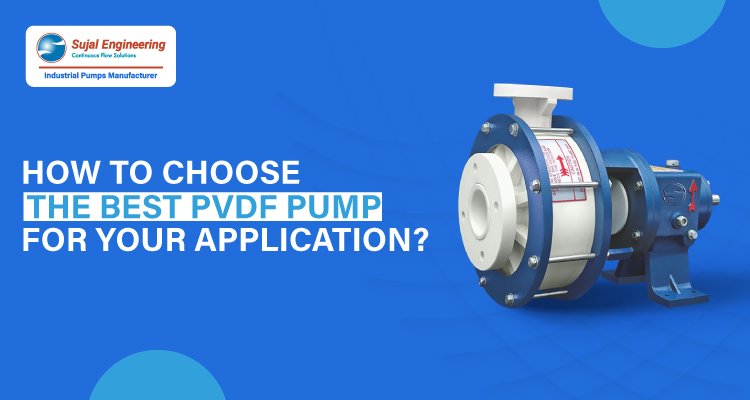How to Choose the Best PVDF Pump for Your Application?

When it comes to pumps used in factories and plants, there’s one type of material that stands out — PVDF pumps.
These special pumps are made from super tough plastic that can handle really harsh chemicals and extreme temperatures.
Whether you’re working with nasty chemicals in a processing plant, dealing with sensitive materials for making computer chips, or treating water, choosing the right PVDF pump can make a huge difference.
But with so many PVDF pumps out there, how do you pick the best one for your specific needs? Don’t worry, we’ve got you covered.
In this guide, we will explore what PVDF pumps are, selection criteria, cost analysis, and long-term benefits.
Overview of PVDF Pumps
PVDF pumps are constructed from a high-performance plastic called polyvinylidene fluoride.
This material is known for its exceptional chemical resistance, durability, and ability to withstand a wide range of temperatures.
Unlike traditional pumps made from metals or other plastics, PVDF pumps can handle even the most aggressive chemicals without succumbing to corrosion or degradation.
These pumps are workhorses in industries where harsh chemicals are involved, such as chemical processing, semiconductor manufacturing, water treatment, and more.
How to Assess Your PVDF Pump Application Requirements?
Before selecting a PVDF pump, it’s crucial to understand your application’s specific requirements.
To get started, you need to identify the chemical properties of the fluid you’ll be pumping.
PVDF pumps are designed to handle a wide range of chemicals, but it’s always best to double-check compatibility to avoid any unwanted reactions.
After that, you need to consider the temperature range your pump will be operating in.
PVDF pumps can typically handle temperatures from -40°F to 275°F (-40°C to 135°C), but make sure to verify the exact range for your application.
Finally, don’t forget to calculate the necessary flow rate and pressure requirements.
Remember, different pump types and sizes are designed for varying flow rates and pressures, so ensure you select a pump that can handle your specific needs.
PVDF Pump Selection Criteria
Now that you’ve assessed your application requirements, it’s time to dive into the pump selection criteria.
First, consider the type of pump you need – centrifugal, positive displacement, or something else. Each type has its own strengths and weaknesses, so choose the one that best suits your application.
Next, ensure that the wetted materials (the parts of the pump that come into contact with the fluid) are compatible with your specific liquid or gas. PVDF is an excellent choice for many chemicals, but some applications may require additional materials like fluoropolymers or ceramics.
The pump’s construction is also crucial. Sealless or mag-drive pumps, for example, can be advantageous in applications where leaks or emissions need to be minimized.
PVDF Pump Installation and Maintenance Considerations
Proper PVDF pump installation is key to ensuring your pump operates at peak performance and maintains its longevity.
That’s why, it’s critical to follow the manufacturer’s guidelines carefully and don’t hesitate to consult with experts if you have any questions or concerns.
More importantly, maintaining your PVDF pump regularly is equally important. This is why you must inspect your pump regularly for signs of wear or potential issues, and follow the recommended maintenance schedule to keep it running smoothly.
If you do encounter any problems, don’t panic. Troubleshooting common issues and implementing potential solutions can often get your pump back up and running without too much downtime.
Remember, having access to spare parts and technical support from the manufacturer can be invaluable. They understand the ins and outs of their products and can provide valuable guidance when needed.
PVDF Cost Analysis and Long-Term Benefits
While PVDF pumps may have a higher initial investment compared to some alternative materials, their long-term benefits can more than make up for the upfront cost.
By selecting the right PVDF pump for your application, you can reduce maintenance costs, minimize downtime, and extend the pump’s lifespan, ultimately saving you money in the long run.
But the benefits don’t stop there. With a properly chosen PVDF pump, you’ll also experience improved process efficiency and productivity, thanks to the pump’s reliable performance and minimal maintenance requirements.
Conclusion
Choosing the right PVDF pump for your application might seem like a daunting task.
But it’s essential to consider the factors we’ve discussed, you’ll be well on your way to making an informed decision.
Remember, proper installation, maintenance, access to spare parts, and technical support are also crucial for ensuring your PVDF pump operates optimally and provides long-lasting service.
If you’re still unsure about which PVDF pump is the best fit for your application, don’t hesitate to consult with experts or reach out to manufacturers like Sujal Pumps.
We, at Sujal Pumps, understand the importance of selecting the right PVDF pump for your specific needs. With decades of experience in manufacturing high-quality pumps, we can guide you through the process and help you find the perfect solution.
Our team of experts is always ready to answer your questions, provide technical support, and ensure that you get the most out of your PVDF pump investment.





